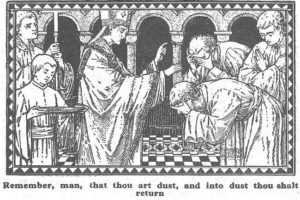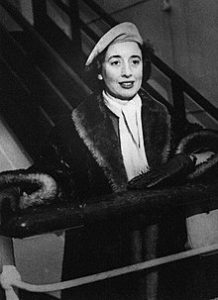Mount Calvary Church
Eutaw Street and Madison Avenue
Baltimore, Maryland
A Parish of the Roman Catholic Personal Ordinariate of St. Peter
Anglican Use
Rev. Albert Scharbach, Pastor
Ash Wednesday
February 14, 2018
Noon Said Mass with conferral of ashes
7:00 PM Sung Mass with conferral of ashes
____________________________
Prelude
Erhalt uns, Herr, bei deinem Wort, BWV 1103, J.S. Bach
Hymns
Lord, who throughout these forty days
This is our accepted time
The glory of these forty days
Anthems
Lord, in Thy rage, rebuke me not, William Byrd
The Lenten Prose, Attende Domine
Postlude
Attende Domine from op. 8, Jeanne Demessieux (1921-1968)
____________________________________________________
Prelude
Erhalt uns, Herr, bei deinem Wort, BWV 1103 – J.S. Bach (1685-1750)
Here it is played by Thorsten Pirkl an der Kreienbrink-Orgel in the Pfarrkirche Maria Hilf, Bachrain
______________________________________________
Hymns
Lord, who throughout these forty days
Claudia Frances Ibotson Hernaman’s hymn, Lord, who throughout these forty days, signals the beginning of Lent and is often sung during Ash Wednesday services or throughout the season of Lent. Forty is a number with special biblical significance. It rained for forty days and nights when the earth was overtaken by floodwaters, and Noah waited another forty days before opening the window of the Ark. Israel wandered in the desert for forty years. Jesus was seen on earth following the resurrection for forty days. In this case, Christ’s forty days in the wilderness provides the primary paradigm for the forty days of Lent.
Claudia Hernaman (1838-1898) was born in Surrey, England, and died in Brussels, Belgium. She was the daughter of an Anglican minister, and she married a minister who also served as a school inspector. Like so many other women hymn writers of the nineteenth century, she was devoted to the religious education of children. Toward this end, she wrote 150 hymns in several collections, some original and some translated from Latin.
“Lord, Who Throughout These Forty Days” appeared first in her Child’s Book of Praise; A Manual for Devotion in Simple Verse (1873). It was not included in hymnals, however, until the mid-twentieth century, when it appeared in the Irish Church Hymnal (1960) and Hymns for Church and School (1964). By the 1970s, “Lord, who throughout these forty days” was a standard hymn in most hymnals in the United States. It is based on the account of the temptation of Jesus found in three Gospels — Matthew 4:1-11; Mark 1:12-13; Luke 4:1-13.
As is the case with many hymns, Christ’s life becomes a model for how his followers should confront temptation. The first two lines of the stanzas focus on a response of Christ when he faced temptation; the last two lines encourage Christians to model their behavior on Christ’s example. This is a familiar pattern for children’s hymns from the days of Isaac Watts. It obviously strikes a chord with adult believers as well.
The classic themes of the Lenten season are presented in the stanzas of this hymn:
Fasting and prayer (stanza one);
Struggle with Satan and sin (stanza two);
Dying to self, meditation on scripture (stanza three);
Penitence (stanza four);
Looking toward the joy of Easter (stanza five).
Lord, who throughout these forty days,
For us didst fast and pray,
Teach us with thee to mourn our sins,
And close by thee to stay.As thou with Satan didst contend,
And didst the victory win,
O give us strength in thee to fight,
In thee to conquer sin.As thou didst hunger bear and thirst,
So teach us, gracious Lord,
To die to self, and chiefly live
By thy most holy word.And through these days of penitence,
And through thy Passion-tide,
Yea, evermore, in life and death,
Jesus! with us abide.Abide with us, that so, this life
Of suffering overpast,
An Easter of unending joy
We may attain at last!
Claudia Frances Ibotson Hernaman (1838-1898) was the daughter of the Rev. William Haywood Ibotson, was perpetual curate of Addlestone. She married the Rev. J.W.M. Hernaman, a school inspector. She was the author of The Child’s Book of Praise: A Manual of Devotion in Simple Verse (1873), and co-editor (with Elizabeth Harcourt Mitchell and Walter Plimpton) of the Anglo-Catholic Altar Hymnal: A Book of Song for Use at the Celebration of the Holy Eucharist (words-only edition 1884, with music 1885). She also published The Crown of Life: Verses for Holy Seasons (1886) and wrote The Conversion and Martyrdom of St Alban: a Sacred Drama (1891). She edited an anthology, Lyra Consolationis. From the poets of the seventeenth, eighteenth and nineteenth centuries (1890).
This seems to be the best version availability on You Tube.
___________________________
This is our accepted time
This is our accepted time was written in 1955 by the Sulpician priest Fr. Michael Gannon. It is set to the 1609 tune, WEIMAR (Vulpius) by composer, Melchior Vulpius (c.1560–1615).
______________________________
The glory of these forty days
In this Lenten hymn attributed to Pope St. Gregory the Great (540—604), The glory of these forty days, the typology so frequently used by the Fathers is employed. We are told that our fast, which we keep in imitation of our Lord’s fast, was prefigured in the Old Testament – by Moses, fasting before receiving the Law; by Elijah who, while fasting, was given the vision of the chariot of fire; and by Daniel who, through fasting and meditation, was delivered from the lions’ den. And, as St. John the Forerunner fasted and became the herald of the Messiah, we pray that we may, through our fasting, be prepared to see our Lord.
The translator was Maurice Frederick Bell (1862-1947). He graduated from Hertford College., Oxford (B.A. 1884, M.A. 1887), was ordained a deacon in 1885, and a priest in 1886, and was Vicar of St. Mark, Regent’s Park, London. He contributed to The English Hymnal, 1906, four translations , and “O dearest Lord, by all adored” (Close of Festival), 1906.
1. The glory of these forty days
we celebrate with songs of praise,
for Christ, through whom all things were made,
himself has fasted and has prayed.2. Alone and fasting Moses saw
the loving God who gave the law,
and to Elijah, fasting, came
the steeds and chariots of flame.3. So Daniel trained his mystic sight,
delivered from the lions’ might,
and John, the Bridegroom’s friend, became
the herald of Messiah’s name.4. Then grant us, Lord, like them to be
full oft in fast and prayer with thee;
our spirits strengthen with thy grace,
and give us joy to see thy face.5. O Father, Son and Spirit blest,
to thee be every prayer addressed,
who art in threefold name adored,
from age to age, the only Lord.
Here is St. John’s, Detroit.
The tune ERHALT UNS, HERR appeared in Joseph Klug’s Geistliche Lieder, Wittenberg, 1535.
_______________________________
Anthems
Lord, in Thy rage, rebuke me not, William Byrd (1540-1623)
Lord in thy rage rebuke me not for my most grievous sin, nor in thine anger chasten me, but let me favour win. Have mercy Lord on me, because my state is weak to see, heal me, O Lord, for that my bones are troubled sore in me.
Here it is sung by Sarah Stowe.
_________________
The Lenten Prose, Attende Domine
Refrain: Hear us, O Lord, have mercy upon us, for we have sinned against thee. 1. To thee, Redeemer, on thy throne of glory, lift we our weeping eyes in holy pleadings: listen, O Jesus, to our supplications. 2. O thou chief cornerstone, right hand of the Father, way of salvation, gate of life celestial, cleanse thou our sinful souls from all defilement. 3. God, we implore thee, in thy glory seated, bow down and hearken to thy weeping children: pity and pardon all our grievous trespasses. 4. Sins oft committed now we lay before thee: with true contrition, now no more we veil them: grant us, Redeemer, loving absolution. 5. Innocent, captive, taken unresisting; falsely accused, and for us sinners sentenced, save us, we pray thee, Jesus our Redeemer.
Here it is sung at Hereford Cathedral.
The Lenten Prose is a translation of Attende Domine, a 10th century hymn composed by Mozarabic Christians.
Attende Domine, et miserere, quia peccavimus tibi. Hearken, O Lord, and have mercy, for we have sinned against Thee.
Ad te Rex summe, omnium redemptor, oculos nostros sublevamus flentes: exaudi, Christe, supplicantum preces. R.
Crying, we raise our eyes to Thee, Sovereign King, Redeemer of all. Listen, Christ, to the pleas of the supplicant sinners. R.
Dextera Patris, lapis angularis, via salutis, ianua caelestis, ablue nostri maculas delicti. R.
Thou art at the Right Hand of God the Father, the Keystone, the Way of salvation and Gate of Heaven, cleanse the stains of our sins. R.
Rogamus, Deus, tuam maiestatem: auribus sacris gemitus exaudi: crimina nostra placidus indulge. R.
O God, we beseech Thy majesty to hear our groans; to forgive our sins. R.
Tibi fatemur crimina admissa: contrito corde pandimus occulta: tua Redemptor, pietas ignoscat. R.
We confess to Thee our consented sins; we declare our hidden sins with contrite heart; in Thy mercy, O Redeemer, forgive them. R.
Innocens captus, nec repugnans ductus, testibus falsis pro impiis damnatus: quos redemisti, tu conserva, Christe. R.
Thou wert captured, being innocent; brought about without resistance, condemned by impious men with false witnesses. O Christ keep safe those whom Thou hast redeemed. R.
Here is the Latin with Gregorian chant.
____________________
Postlude
Attende Domine from op. 8, Jeanne Demessieux (1921-1968)
Here is the Choral-paraphrase on ‘Attende Domine’ played a person with the wonderful name D’Arcy Trinkwon in St Paul’s Cathedral, London, on 5 July 2001.
Born in Montpellier, Jeanne Demessieux was the second child of Marie-Madeleine Demessieux (née Mézy) and Étienne Demessieux. After taking private piano lessons with her elder sister, Yolande, Jeanne entered the Montpellier Conservatoire in 1928. Four years later, she obtained first prizes in solfège and piano. In 1933, she began her studies at the Paris Conservatoire; studying piano with Simon Riera and Magda Tagliaferro, harmony with Jean Gallon, counterpoint and fugue with Noël Gallon, and composition with Henri Büsser. The same year, she was appointed titular organist at Saint-Esprit, a post she held for 29 years.
From 1936-39, Demessieux studied organ privately with Marcel Dupré, whose organ class at the Conservatoire she joined in 1939. After receiving a first prize in organ performance and improvisation in 1941, Demessieux studied privately with Dupré in Meudon for five more years, before she played her début concert at Salle Pleyel in Paris in 1946. This was the beginning of her career as an international concert organist. Demessieux gave more than 700 concerts in France, the United Kingdom, Belgium, the Netherlands, Switzerland, Germany, and the United States. She had memorized more than 2,500 works, including the complete organ works of Bach, Franck, Liszt, and Mendelssohn, and all of Dupré’s organ works up to Opus 41. A prolific recording artist, she was awarded the Grand Prix du Disque Award in 1960 for her complete recording of Franck’s organ works (1958).
In 1962, Demessieux was appointed as titular organist at La Madeleine in Paris. She combined this with demanding academic duties, serving as professor of organ both at the Nancy Conservatoire (1950–52) and later at the Conservatoire Royal in Liège (1952–68). In 1967, she signed a contract with Decca for a recording of the complete organ works by Olivier Messiaen, which was not realized due to her death the following year.
Jeanne Demessieux died in Paris on 11 November 1968 from the effects of throat cancer. A large crowd, including Marcel Dupré, attended her funeral at La Madeleine. The great organ remained silent, and a vast black drape hung from the gallery to the floor.

